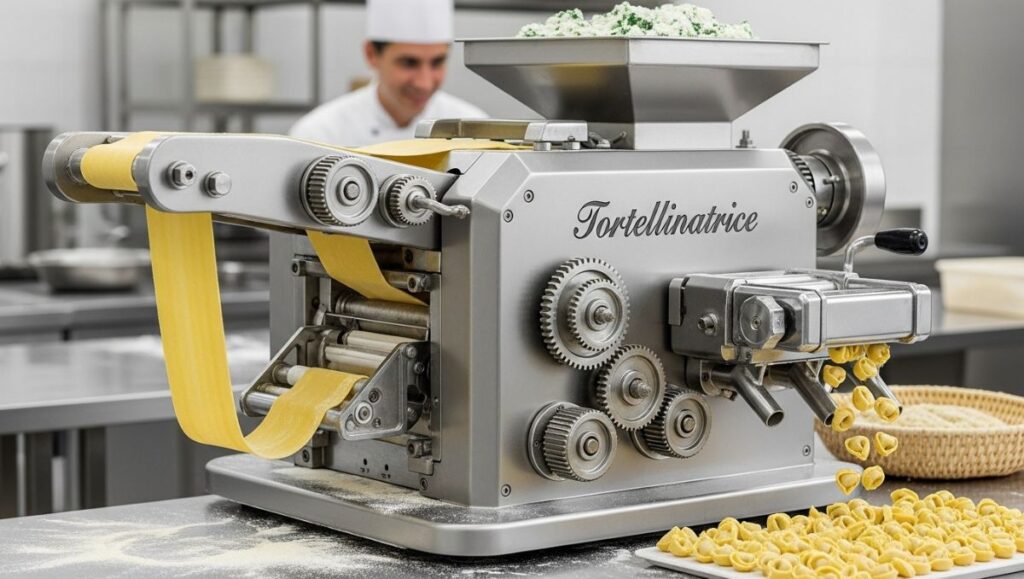The tradition of making tortellini is one of the most cherished culinary practices in Italian cuisine. These small, ring-shaped pasta parcels—usually filled with meat, cheese, or vegetables—have been prepared by generations of skilled hands. However, as food production evolved, the need for consistent quality, higher output, and efficient production methods led to the creation of a specialized machine: the tortellinatrice.
Today, the tortellinatrice stands at the crossroads of tradition and innovation. It preserves the authentic shape and texture of tortellini while bringing modern efficiency to kitchens, restaurants, and pasta factories. This article explores its history, functionality, features, benefits, and its growing role in contemporary culinary production.
What Is a Tortellinatrice?
A tortellinatrice is a pasta-making machine specifically engineered to produce tortellini. Its primary functions include:
-
Rolling and flattening pasta dough
-
Depositing precise amounts of filling
-
Folding and shaping each tortellino
-
Ensuring consistency in size and structure
Available in manual, semi-automatic, and fully automated models, the tortellinatrice is designed to replicate the appearance and quality of hand-crafted tortellini while drastically increasing production speed.
Origins and Evolution
From Hand Craft to Mechanization
Traditional tortellini were made entirely by hand—rolled, cut, filled, and shaped manually. While artisanal techniques remain valuable, they require:
-
Technical skill
-
Time-consuming labor
-
Slow production output
As pasta grew in global popularity, pasta makers sought ways to scale production without losing authenticity. This led to the invention of pasta machines capable of shaping various forms, including tortellini.
Technological Advancements
Modern tortellinatrice models now incorporate:
-
Precision engineering
-
Adjustable filling systems
-
Automatic folding mechanisms
-
Digital controls for speed and output
-
Stainless steel structures for hygiene and durability
These advancements allow businesses to produce thousands of tortellini per hour without compromising quality.
How a Tortellinatrice Works
While each model varies, most tortellinatrici function through a standard three-stage system:
1. Dough Handling
The machine accepts a sheet of pasta dough—either rolled manually or produced by a separate dough sheeter. The tortellinatrice keeps the sheet at a uniform thickness for consistent cooking.
2. Filling Application
A calibrated nozzle injects the filling at perfectly spaced intervals. This ensures each tortellino contains:
-
The exact amount of filling
-
Even distribution
-
Reduced waste
From meat mixtures to cheese blends, the machine handles a wide range of textures.
3. Folding and Forming
This is where the magic happens. The machine folds the dough around the filling, seals the edges, then shapes it into the classic tortellini ring. High-end models mimic traditional hand-folding techniques to maintain authenticity.
Key Features of Modern Tortellinatrici
1. Adjustable Filling Systems
Users can control:
-
Filling quantity
-
Filling texture
-
Filling density
This flexibility supports traditional recipes and modern variations.
2. Size Variability
Machines can be set to produce different sizes of tortellini:
-
Mini tortellini (for soups)
-
Medium-sized varieties
-
Large tortelloni (filled pasta similar to ravioli)
3. Stainless Steel Construction
Durable and easy to sanitize, this is essential for professional kitchens.
4. High Output Efficiency
Depending on the model, production rates range from hundreds to thousands of pieces per hour.
5. Safety and Hygiene Controls
Features include:
-
Food-grade materials
-
Safety guards
-
Easy-to-clean surfaces
-
Anti-contamination engineering
Benefits of Using a Tortellinatrice
1. Consistency and Quality
The machine ensures uniform shape, size, and filling, which is critical for:
-
Cooking time
-
Presentation
-
Packaging
2. Increased Production
What would take hours by hand can be completed in minutes.
3. Cost Efficiency
Reduced labor requirements translate into significant savings, especially in large-scale operations.
4. Versatility
Many machines allow production of multiple filled pasta types, making them valuable investments.
5. Preservation of Tradition
Contrary to concerns that machines “replace” artisans, tortellinatrici actually help preserve traditional shapes and filling techniques by maintaining consistency and preventing human error.
Who Uses a Tortellinatrice?
1. Pasta Factories
Large facilities rely on automated tortellinatrici to meet high production demands for retail and export.
2. Restaurants and Hotels
Semi-automatic machines help chefs produce fresh, consistent tortellini in-house.
3. Artisanal Pasta Shops
Smaller models assist pasta artisans who want to retain handcrafted quality while increasing output.
4. Catering Companies
Events requiring large quantities of fresh pasta benefit immensely from these machines.
Types of Tortellinatrici
Manual Tortellinatrice
-
Requires more user input
-
Suitable for small batches
-
Ideal for culinary schools or home-based businesses
Semi-Automatic
-
Combines hand control with automation
-
Popular in restaurants and medium-sized shops
-
Offers a balance of tradition and efficiency
Fully Automatic
-
Handles dough, filling, folding, and shaping
-
Best for industrial-scale production
-
Maximizes speed and accuracy
Tortellinatrice and the Future of Pasta Production
The growing global demand for fresh, high-quality pasta is reshaping the food production landscape. As consumers increasingly expect authenticity and consistency, the tortellinatrice plays an essential role in meeting these expectations.
Future innovations may include:
-
AI-assisted filling control
-
Smart sensors for dough thickness
-
Energy-efficient motors
-
Modular designs for multi-format pasta production
These improvements will help pasta makers maintain traditional flavors while benefiting from the precision of modern engineering.
Conclusion
The tortellinatrice is more than a pasta machine—it is a symbol of how tradition and technology can complement one another. It respects the heritage of Italian cuisine while enabling businesses of all sizes to produce delicious, consistent, and authentic tortellini efficiently.
Whether used in small artisan shops or large industrial factories, the tortellinatrice ensures that one of Italy’s most iconic dishes continues to thrive in kitchens around the world.






